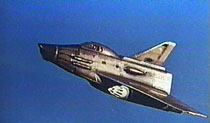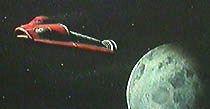

| Photos by Phillip D.Rae and Mark Dickson, from the collection of Mark Dickson 
For those of us who grew up in the 60's, Gerry Anderson needs no introduction. Best known for his marionette sci-fi serials, such as Stingray, Fireball XL-5, Supercar, Thunderbirds, and Captain Scarlet, Anderson was the media sci-fi creator for kids of that decade. Aside from the increasingly sophisticated puppetry of his "Supermarionation" technology, the Gerry Anderson hallmark was always cool, high-tech vehicles. In many ways, these were often the main characters of his series. As the sixties drew to a close, Anderson began to shift his focus from puppet actors to flesh and blood. Along with that was an increase in sophistication in order to appeal to an older audience (which made perfect sense, as the kids who were weaned on his puppet shows were growing up). His first live-action series was 1969's "UFO". Set in the far future of 1980 (that's the 1980 where Beatle suits were in and we all drove turbine cars), the show centered around a secret international organization called SHADO, whose goal was to covertly combat an alien menace with its eyes on Earth. "UFO" was no exception to the Anderson hardware rule. If anything, it raised the bar to new heights. In its battle against extraterrestrial invaders, SHADO employed submarines, lunar interceptors, ground attack vehicles, orbital detection hardware, a moonbase, an underground HQ, and much more. This page features quality, detailed photos of many of the UFO studio models. |
Skydiver | Sky One | Interceptors | Lunar Module | S.I.D. | Mobiles
Mobile Aerial Transporter | Moon Mobile | Straker's Car | Foster's Car
Hypersonic Transport | UFO
|
SKYDIVER | ||

IMAGES: |
Skydiver was an advanced attack submarine operated by SHADO in their war against the aliens. The organization operated three such vessels, whose existence was top secret. The front part of the sub was an aerial fighter (Sky One), which could launched from beneath the surface of the water to maintain secrecy and use the element of surprise in ambushing UFOs already in the atmosphere. The Skydivers were berthed in underground docks (in Britain and presumably elsewhere), linked to the sea by long tunnels. |
|
| SKY ONE | ||
 IMAGES: | Skydiver had about a four-man crew, with the captain usually serving as the pilot for Sky One, a twin-engine fighter. Its primary offensive armaments were two missile pods slung under the craft's small wings and four nose-mounted cannons. A boarding tunnel ran from the control room of Skydiver, through the back of Sky One and into the cockpit area. This way the craft could be quickly scrambled in combat situations. There were three sizes of Sky One used on the show: the two on the Skydiver models, and the larger one (though this was not much larger than the medium ones). The large one was specially made for flying shots (though the others did their share) and is made of the thinnest, lightest fiberglass possible. The larger model holds a little more in the way of detail. There are also minor structural differences between the two sizes of models, such as the gun pod caps. | |
| INTERCEPTORS | ||
 IMAGES: | SHADO's first line of defense against attacking UFOs was Moonbase (which is rumored to be the precursor to Space:1999's Moonbase Alpha - in fact Space:1999 began life as a UFO sequel!). This outpost was defended by a variety of weapons, such as lunar tanks. But clearly it's strongest anti-UFO punch came from its Interceptors. Housed in an underground hanger near Moonbase, these could be scrambled at a moment's notice (see picture to the left). The Interceptors were single-shot missile ships. Their bulbous nose was actually a proximity nuclear warhead which could be fired at advancing UFOs. Unfortunately this meant that once their missile was fired, they were defenseless. This is not a good thing, given how many times they missed over the course of the series. The Interceptors were strictly controlled from Moonbase. The pilots had little autonomy. | |
| LUNAR MODULE | ||
 IMAGES: | With a fully active Moonbase, SHADO needed a vehicle to ferry supplies and personnel from Earth. The Lunar Module filled that role. The LM was fitted within a large VTOL aircraft which would leave from an airbase, climb to great altitude, then release the LM to continue the climb to orbit. The intake on the nose implies that some kind of ramjet or scramjet was involved. Once the LM reached the Moon, it would land, tail first, on a pad at the center of SHADO's Moonbase. By all appearances, the LM was not an elegant shuttle. Its passengers probably got a pretty rough-and-tumble ride. This ship is so ugly, even an A-10 Warthog would have a hard time loving it. It stands out for this reason, alone. Its similarity to a large-mouthed fish is immediately striking to anyone who sees the craft. | |
| S.I.D. (Space Intruder Detector) | ||
 IMAGES: | One of Gerry Anderson's undisputed talents was breathing life into his hardware and making them as much a character as the flesh-and-blood actors. S.I.D. is perhaps the epitome of Anderson's skill in humanizing the inanimate. Through both its name and calm, controlled voice, S.I.D. became a familiar cast member with its own distinct personality. Character traits aside, S.I.D. was SHADO's primary space detection platform. Located in high Earth orbit, S.I.D.s scanners could reach beyond the orbit of the Moon to detect UFOs. S.I.D. was also remarkably adept at calculating their exact landing site, based on their inbound trajectories. | |
| MOBILES | ||
 IMAGES: | If SHADO is sloppy enough (or the aliens clever enough) that a UFO gets through all the Lunar and airborne defenses (not uncommon), then it's time to get down and dirty. Call out the Mobiles! These are tracked vehicles with minor offensive capability and lots of sensor equipment. They are covertly delivered to a UFO landing site, via a carrier truck or SHADAIR transport. Once on site, they can locate the UFO and deliver personnel to carry out whatever mission SHADO deems necessary (search and destroy, recovery, or whatnot). | |
| MOBILE AERIAL TRANSPORTER | ||
 IMAGES: | SHADO employs various transport modes to get Mobiles to the site of a downed UFO. When the craft crashes on mainland Britain, SHADO traditionally employs large, unmarked transporter trailers. However, if the crash site is in a distant location, SHADO has a transport aircraft specifically designed to get Mobiles to the scene. The Mobiles load/unload via a tail ramp, much like the C-130. | |
| SHADAIR HYPERSONIC TRANSPORT | ||
 IMAGES: | SHADO has (presumably) a small fleet of hypersonic aircraft for transporting important people and things. The styling of this vehicle is a cool cross-breed of the Concorde and the XB-70. This vehicle is used in domestic and transcontinental operations. | |
| MOON MOBILE | ||
 IMAGES: | The workhorse of SHADO's operations around Moonbase and on the lunar surface is the Moon Mobile. This is a surface-skimming vehicle. Moonbase's Mobiles are kept in a hanger just below the Lunar Module landing pad. | |
| STRAKER'S CAR | ||
 IMAGES: | When UFO was in production, the concept of turbine driven autos were becoming all the rage. That reality was short circuited by the onset of the Gas Crisis, in the mid-seventies, but it was firmly embraced in UFO's interpretation of 1980. Two different styles of turbine cars were used throughout the show. One is strongly associated as "Commander Straker's car". These vehicles existed as full sized props, as well as models. Most of the images presented here are just those of the models. | |
| FOSTER'S CAR | ||
 IMAGES: | The second car is often associated with Colonel Foster, though it was used in other automotive roles as well. As with Straker's Car, the images below illustrate the model used with miniature sets. | |
| UFO | ||
 IMAGES: | What can one say about the UFOs. They may be design most associated with the series (and as series' namesake, rightly so). Little is known about these ships beyond the fact they can operate in both an atmosphere, underwater, and in space. They carry a potent beam weapon. They also make a cool sound as they fly! | |
|
UFO characters and images are copyright ITC Entertainment and Carlton Communications. This page is best viewed by a system carrying the 'Haettenschweiler' font. Please direct comments, questions, corrections, and picked nits to the Starship Modeler staff. Last updated 8 July 2004. This page copyright 1999-2004, Starship Modeler. |